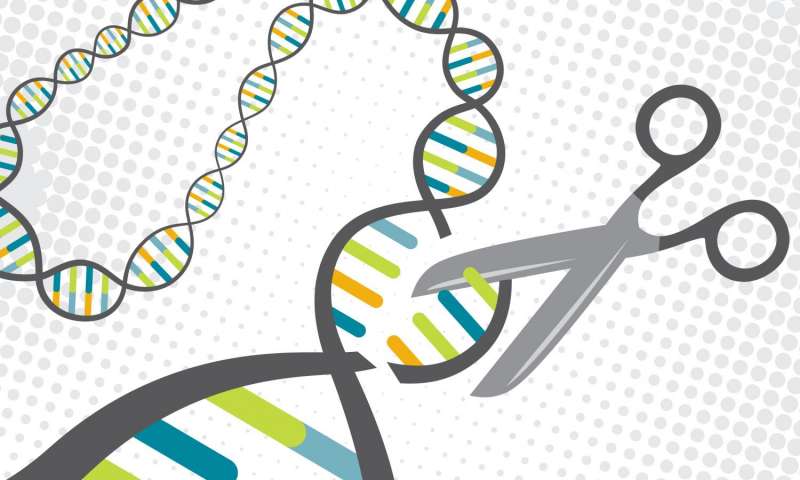CRISPR: The Power to Forever Change Humanity
From curing cancer to making Super Humans
By Stella Law
 癌症一直是整个医学界和全人类试图攻克的难题。就目前所有的医疗技术手段而言,尚未发现一种对癌症完全有效的治疗方法。但最近,人类收到了一个福音——据英国《自然》杂志网站、美国《麻省理工技术评论》网站今年一月的消息称,美国宾夕法尼亚大学目前正在为CRISPR基因编辑技术抗癌的人类临床试验做最后阶段的准备,项目即将全面启动。这是美国使用CRISPR治疗癌症的首次尝试,标志着肿瘤治疗进入一个新时代,也打响了中美之间一场生物医学竞赛。
癌症一直是整个医学界和全人类试图攻克的难题。就目前所有的医疗技术手段而言,尚未发现一种对癌症完全有效的治疗方法。但最近,人类收到了一个福音——据英国《自然》杂志网站、美国《麻省理工技术评论》网站今年一月的消息称,美国宾夕法尼亚大学目前正在为CRISPR基因编辑技术抗癌的人类临床试验做最后阶段的准备,项目即将全面启动。这是美国使用CRISPR治疗癌症的首次尝试,标志着肿瘤治疗进入一个新时代,也打响了中美之间一场生物医学竞赛。
CRISPR,即规律成簇的间隔短回文重复(Clustered Regularly Interspaced Short Palindromic Repeats),是大多数细菌及古细菌中的一种获得性免疫方式。CRISPR可谓是近年生物界的焦点,这项技术相对与ZFN,TALEN等基因打靶技术可以说是简便,经济得多,一般的实验室都可以构建自己的平台。CRISPR在细菌体内本来是起适应性免疫作用的(有点像人的获得性免疫)。细菌被病毒感染了,当然也不会束手就擒。病毒感染细菌,对于细菌而言就是细胞内多了 不是自己的DNA序列,这些序列可能表达出一些对细菌本身有害的的蛋白,所以细菌只要把这些外来的DNA破坏掉就可以了。
CRISPR就是这么一套很巧炒的系统。它先把外来DNA的片段整合进细菌自己的基因组,然后转录出RNA,经过一些剪切之后,利用这些RNA把带有DNA内切酶活性的Cas蛋白直接引导到外源序列的位置,于是,外源DNA就可以被剪断。对于细菌而言,就完成了对外来病原体的快速精确打击。 这些整合进基因组的序列还可以传给子代细菌(要是人的免疫可以这么遗传,就不用每个小孩都拉去打疫苗了),所以CRISPR现在也被用作微生物分类的依据。
将CRISPR基因编辑技术用于治疗癌症,被医学界认为是一种革命性的癌症疗法。
CRISPR系统不但丰富了我们对于细菌、古细菌生理机制的认知,更重要的是这种体系的改造利用 能带来席卷整个分子生物学领域,更新现有操作模式的一场技术革命。同时,它也为我们打开了扇窗,从 CRISPR的角度重新认识整个微生物世界自我和相互间的调控网络、调控机制,原核及真 核细胞间的异同和联系,甚至协同进化的证据。
 In case you haven’t heard, scientists are on the verge of ushering a new era in the field of medical science using a genome editing tool called CRISPR. It’s nothing like anything we have seen before. This new technique is so radically different and advanced that it could forever change us as a species.
In case you haven’t heard, scientists are on the verge of ushering a new era in the field of medical science using a genome editing tool called CRISPR. It’s nothing like anything we have seen before. This new technique is so radically different and advanced that it could forever change us as a species.
Yes, CRISPR is revolutionary. It could bring unprecedented changes to our lives by formulating cures for even the worst of diseases, including humanity’s worst enemies – Cancer and HIV.
But that’s not all – scientists can also use CRISPR to create targeted mutations in plants, pets and livestock to make them healthier and fancier. If you choose to ignore the obvious moral dilemmas for a moment, CRISPR could also let us create “designer” babies with pre-chosen genetic traits. Would you like blue eyes and curly hair for your future-kid? CRISPR can do it for you. Want to give her a naturally tall and athletic build? CRISPR has the perfect solution.
Sure, we are yet to cover some distance before any of those can become a reality, but clinical trials on humans have already started and are expected to yield results in the foreseeable future.
On June 21st, 2016, an advisory panel at the US National Institute of Health (NIH) waved the green flag at the first ever clinical trial of CRISPR Cancer treatment on humans. Less than a month later, a group of Chinese researchers announced that they were preparing to use CRISPR for the treatment of lung cancer patients.
If these trials go as per plan, cancer and many other life-altering diseases could be checkmated with perhaps just a couple of injections or so.
Some might speculate that scientists have been experimenting with genomes for several decades now. So what’s the fuss about CRISPR now?
Well, it is because CRISPR allows the editing of genomes with never-seen-before precision, efficiency, and flexibility. Moreover, animal testing of CRISPR-based treatment methods have, so far, had a high success rate, which has further boosted the hype surrounding it.
 So, what exactly is CRISPR?
So, what exactly is CRISPR?
Genetic modification is not exactly a new thing. Our ancestors figured it out thousands of years ago and they used it to strengthen certain traits in plants and animals using selective breeding. The goal was to enrich their lives with better and healthier crops and livestock. This was one of the landmark achievements during the early days of the first Agricultural Revolution (circa 10,000 BC).
While they became extremely efficient in this field, our distant ancestors didn’t quite understand the science behind selective breeding of plants and animals. It remained an enigma till the mid-20th century when scientists discovered deoxyribonucleic acid (DNA), the building block of all Earth-life.
With the discovery of DNA came the realization that much of our physical traits and personality - from the colour of our eyes to our allergies and vulnerabilities to certain diseases - are encoded in our DNA.
Scientists now understood and realized that they had the power to take charge of evolution by artificially tweaking the genetic information stored in our DNA. Plant and animal testing began with the goal to modify and study DNA sequences using radiation and chemicals.
Within a few decades, they were able to create genetically modified plants and animals for fun and utilitarian purposes. (For example, fluorescent fishes that glow from the inside out, enabling scientists to observe the effect of pollutants in the body) Despite this success, researchers were unable to precisely control genetic mutations. Therefore, the success or failures of many of these experiments were almost always left to fate.
The real breakthrough came with the discovery of CRISPR/Cas9. CRISPR-based genetic modification techniques are so accurate that scientists could plan and execute a single change in three billion DNA bases. On top of that, it is also relatively affordable, which is good for encouraging mass acceptance for moving forward.
 CRISPR Is an Ancient Biological Weapon against Viruses
CRISPR Is an Ancient Biological Weapon against Viruses
In the late 1980s and early 90s, research teams in Japan, Holland, and Spain independently identified a mysterious part of DNA sequence that repeated itself in a very specific way. Scientists named it Clustered Regularly Interspaced Short Palindromic Repeats, or simply CRISPR.
Further studies revealed the whole story behind the origin of CRISPR. Apparently, CRISPR is a naturally-occurring ancient defense mechanism found in a wide range of bacteria. It provides protection from viruses and other foreign molecular parasites that invade individual bacterium and take control over their genome.
Just like humans, bacteria and other single-cell life forms are routinely attacked by viruses too.
For single-cell bacteria, such attacks result in an immediate do-or-die situation as any significant damage to their only cell implies imminent death. These standoffs between the two microorganisms began billions of years ago – long before the emergence of complex multi-cellular life forms.
Whenever a bacterium is faced with new and dangerous virus, it doesn’t immediately know how to defend itself. Its immune system has to do some on-the-job learning to put up an effective defense. Subsequently, many bacteria die without putting much of a fight.
However, those that survived managed to copy a part of the invading virus’s DNA strand into its own genetic code. Think of it as the bacterium saving the virus’s DNA strand in a DNA archive for future use. This archive is what we call the CRISPR sequence. In the event of a follow-up virus invasion, the bacterium will make multiple RNA copies from said DNA archive to arm a protein called Cas9 (CRISPR Associated Systems).
Cas9 then matches the invading virus’s DNA with the DNA strand stored in its archive. If it was a 100% match, the bacterium’s immune system would cut out the virus’s DNA, removing any threat. This ancient defense mechanism has since been a vital ingredient in many bacteria’s immune system.
(Note: This is a simplification of an otherwise very complicated process that’s beyond the ambit of this article.)
So, Does CRISPR Make It Possible to Modify anyone’s DNA?
Great question! We are not quite there yet, but the progress thus far has been rather impressive. Animal testing is going as per plan and scientists have already pulled off certain complicated genetic alterations in monkeys using targeted mutations. Previous experiences on mice were also successful.
Other experiments have shown that CRISPR-Cas9 techniques can be used to resist HIV infection as well. The most promising experiment is currently underway in China where scientists are trying CRISPR to cure adult lung cancer patients by removing the compromised DNA from affected cells.
CRISPR techniques will most likely be used to accomplish other objectives as well. For example, in addition to making yourself cancer-free, you could also render your unborn child immune to a range of diseases by making minute changes in his/her DNA. And while you are at that, how about giving him/her a perfect eyesight and enhanced intelligence? See where this is heading?
This is a pretty much the textbook definition of a slippery slope situation. Leave the progress of CRISPR unchecked, and genetically modified super-humans could soon become the new norm. As you would guess, there are serious ethical and moral implications if such a scenario was ever to play out for real.
Future of CRISPR
We shouldn’t forget that the progress of CRISPR research, while on a promising trajectory, is built on lessons drawn from many failed cases. Moreover, accurately repeating even the most successful experiments requires serious labour and investment. The path forward is not without its fair share of challenges.
Admittedly, a lot needs to be done before this new technology can transform humanity for the better by eliminating diseases and contributing in various other ways. On this shinier side, however, future research work will mostly require fine-tuning the application of existing knowledge rather than making challenging discoveries.
CRISPR is happening – it’s not a matter of “if,” but a matter of “when.” So, maybe the time is ripe for policymakers to seriously ponder over many theoretical questions we have about gene manipulation, weaponized organisms, designer babies, and human augmentation.
After all, judging by the speed at which CRISPR technologies are evolving, the day seems not so far when those questions will become much more than just theoretical issues.